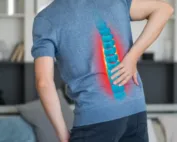Introduction:
Back pain affects millions worldwide, often leading to disability and missed workdays. Yet, timely identification and effective management can restore mobility and comfort. This comprehensive guide explores key strategies for addressing back pain, from understanding its causes to accessing expert care in California.
Key Takeaways:
- Back pain is a prevalent issue affecting 80% of the population at some point.
- Identifying the cause is crucial for effective management.
- Non-invasive techniques include exercise, therapy, and medication.
- Invasive methods like injections and implants are for severe cases.
- Seeking timely treatment is essential to prevent workdays lost to pain.
What is pain management for back pain, and how can it be effectively addressed?
If you’re experiencing back pain, you’re not alone. It’s a leading cause of disability and missed work globally. This guide provides insights into effective pain management strategies and where to find expert help, including in California.
Understanding the root cause of back pain is vital, as prevention is often overlooked. Common causes include poor ergonomics, stress, injuries, and underlying health conditions like arthritis. Identifying the cause enables tailored treatment plans and ruling out associated issues.
If you experience back pain, you are not alone. It is one of the world’s leading causes of disability and missed work. When left untreated, it can severely hinder your quality of life. However, quick identification coupled with effective pain management for back pain can help you overcome the issues to restore mobility and comfort.
Research shows that 80% of the population will experience symptoms at some point in their lives. This guide to managing back pain will answer all of your key questions including;
- When to seek pain management for back pain?
- What are the best managing back pain strategies available?
- Where can you find back pain management California experts?
What Causes Back Pain?
Prevention is always the best form of protection when trying to maintain good health, not least when protecting your back. Sadly, it is stated that around 90% of all patients never discover the root cause of their back pain. Some of the most common reasons, however, are listed below. The list includes;
- Sitting at a poorly designed workstation, with over half of cases linked to sitting at a desk or office jobs.
- Stress, which is directly shown to increase the risk of suffering back pain and musculoskeletal issues.
- Muscle injuries and tendon injuries, particularly those that cause inflammation in the lower back region.
- Underlying healthy conditions including but not limited to Fibromyalgia and Osteoporosis.
- Arthritis, which is experienced by over 54 million Americans, can cause stiffness in the back as well as joints.
Understanding the reason for your back pain is a crucial step that will subsequently enable you to highlight the best back pain management techniques for your personal needs. It can also enable experts to investigate and rule out any linked conditions.
What is Pain Management for Back Pain?
In its simplest definition, pain management for back pain can be characterized as any treatment that reduces or removes symptoms of pain while systematically looking to rehabilitate the affected area. However, pain management is usually separate from surgical procedures. In some cases, it may be used after surgery to cope with the pains that could not be rectified.
Given that back pain can range from dull pains to shooting pains, the solutions for managing back pain is often split into two main types:
- Non-invasive Pain Management Techniques
- Invasive Pain Management Techniques
Non-invasive Pain Management Techniques :
Non-invasive pain management techniques can include medicines, physical therapies, and a host of additional strategies. The most common are listed below:
- Exercise- Regular exercise is an essential feature of musculoskeletal health. A range of water-based, cardio, and strength training exercises can be used to rebuild flexibility, strength, and your range of movement. These results can consequently alleviate symptoms and reduce their frequency.
- Heating and cooling- Heating and cooling of the skin through ice packs and a range of other tools is a popular way to produce immediate pain relief. Ultrasound and diathermy are two options to consider.
- Stem cell therapy- Stem cell therapy can be used as a significant part of chiropractic care. It involves recreating new tissue without involving invasive procedures while it can be used in conjunction with surgery and invasive therapies when required. Back pain is one of the most popular reasons for using it.
- Manual therapies- This group of techniques can relieve pain through adding pressure to the joints, ligaments, and muscles. It can deliver immediate results and is safe to complete time and time again.
- Cognitive therapy- This can include behavioral therapies that focus on improving the body’s responses to back pain. Relaxation techniques and coping mechanisms can be supported by muscle tension, blood pressure, and heart rate control. It helps you during a flare-up while also delivering peace of mind.
Alternatively, a host of medications may be prescribed as a non-invasive pain management for back pain treatment. Options include analgesics, antidepressants, muscle relaxants, narcotics, and NSAIDs.
Invasive Pain Management Techniques :
Invasive pain management for back pain is another common solution that may be used for immediate relief and long-term symptom reduction. The range of solutions includes a combination of one-time and recurrent procedures. They are;
- Injections- Anesthetics and steroids can be delivered to the body via injections, commonly referred to as ‘blocks’. They normally produce an instant but temporary level of pain relief and can be used for joints, ligaments, muscles, and nerves around the back.
- Prolotherapy- This is another procedure that uses injections. However, their purpose is to increase blood circulation. It can reduce pain symptoms with great effect, and is most commonly used for treating localized pain in the ligaments.
- Radioablation- Using small needles, radiofrequency radioablation uses heat transfers to deaden the nerves and relieve pain. It is commonly shown to produce results that last for several months. If your back responds particularly well, it could be years before repeat appointments are required.
- Implants- Surgical implants known as SCSs (spinal cord stimulators) can be used to provide electrotherapy to the peripheral nerves. It should be noted, however, that they are best used to treat the limbs rather than the back itself.
- Implant pumps- The surgically implanted opium infusion pumps provide opium agents directly to the spinal cord, treating chronic back pain by reducing chronic pains in the back region.
Invasive pain management services near me for back pain are usually best used by people with severe and chronic back pain. For those with mild conditions or early signs of chronic conditions, the non-invasive route is preferred.
Back Pain Management California
If you are suffering from back pain, it is vital that you take action ASAP. After all, American citizens lose over 186 million workdays due to back pain each year. The sooner you treat your condition, the sooner you can stop experiencing the daily impacts that over one-third of adults experience.
Here at OC Wellness Physicians California, our team of experts are here to help. We can discuss your symptoms, diagnose the source of your back pain, and identify the best treatment. All of this is done with a friendly and professional approach while we also prodigy ourselves on offering value for money.
To learn more about pain management for back pain, get in touch today!
Recent Blogs
Why Physical Therapy Should Be Your Secret Weapon Before Surgery
Surgery, while sometimes necessary, can be a daunting prospect. The recovery process is often lengthy and filled with unknowns. But what if there was a way to optimize your body's readiness for surgery and [...]
Spinal Decompression Therapy: A Non-Surgical Option for Herniated Discs
The discs in your spine act as cushions between the vertebrae, providing flexibility and absorbing shock. When the outer wall of a disc weakens or tears, the soft inner core can bulge or push [...]
PRP for Knees_ A Promising Option for Pain Relief and Mobility – word
For many people, knee pain is a constant companion, limiting mobility and impacting quality of life. Traditional treatments like pain medication and physical therapy can offer relief, but they may not address the underlying [...]




